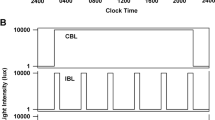Recent studies have shown that melatonin can be secreted, in addition to other sources, by peripheral blood mononuclear cells (PBMCs). We investigated whether melatonin could also be secreted by cultured polymorphonuclear (PMNs) and whole blood (WB) cells under resting and stimulated conditions. In addition, influences of the intensity and color of light on the production of melatonin by these cells were estimated. Blood samples were collected from a healthy volunteer, and PBMCs and PMNs were isolated. The PBMC, PMN, and WB cultures were exposed for 8 h to light intensities of 0, 20, 50, 100, 300, and 500 lux and to white, red, blue, and green lights in the presence/absence of mitogens. Levels of melatonin in supernatants were detected by enzyme-linked immunosorbent assay (ELISA). In addition to PBMCs, PMNs and WB cells were found to also produce melatonin, and this production was increased due to mitogen activations. The most effective intensity of light, which suppresses melatonin secretion, was 100 lux. There were no significant differences between the influences of different monochromatic lights on the melatonin production by the examined blood cell cultures. Thus, PBMCs, PMNs, and WB cultures can produce melatonin, and mitogen activation causes a higher production of this hormone. Moreover, although white light suppressed melatonin secretion at 100 lux, there was no difference among various types of lights.
Similar content being viewed by others
References
M. Singh and H. R. Jadhav, “Melatonin: functions and ligands,” Drug Discov. Today, 19, No. 9, 1410–1418 (2014).
R. Ahmad and C. Haldar, “Photoperiod-testicularimmune interaction in a seasonal breeder indian palm squirrel funambulus pennanti during the reproductively inactive and active phases,” J. Neuroendocrinol., 21, No. 1, 2–9 (2009).
D. R. Mann, M. A. Akinbami, K. G. Gould, and A. A. Ansari, “Seasonal variations in cytokine expression and cell-mediated immunity in male rhesus monkeys,” Cell Immunol., 200, No. 2, 105–115 (2000).
C. B. Moore and T. D. Siopes, “Effects of lighting conditions and melatonin supplementation on the cellular and humoral immune responses in Japanese quail Coturnix coturnix japonica,” Gen. Comp. Endocr., 119, No. 1, 95–104 (2000).
A. Szczepanik, “Melatonin and its influence on immune system,” J. Physiol. Pharmacol., 58, Suppl. 6, 115–124 (2007).
Q. Y. Guo, Z. X. Wang, Y. L. Dong, et al., “Physiological crosstalk between the AC/PKA and PLC/PKC pathways modulates melatonin-mediated, monochromatic-lightinduced proliferation of T-lymphocytes in chickens,” Cell Tissue Res., 369, No. 3, 555–565 (2017).
J. R. Calvo, C. Gonzalez-Yanes, and M. D. Maldonado, “The role of melatonin in the cells of the innate immunity: a review,” J. Pineal Res., 55, No. 2, 103–120 (2013).
A. Carrillo-Vico, P. J. Lardone, J. M. Fernández-Santos, et al., “Human lymphocyte-synthesized melatonin is involved in the regulation of the interleukin-2/interleukin-2 receptor system,” J. Clin. Endocrinol. Metab., 90, No. 2, 992–1000 (2005).
A. Zamani, I. Salehi, and M. Alahgholi-Hajibehzad, “Moderate exercise enhances the production of interferon-γ and interleukin-12 in peripheral blood mononuclear cells,” Immune Netw., 17, No. 3, 186–191 (2017).
H. Shintani, “Isolation of neutrophils/assay of O2 – (superoxide anion radical) generation by cytochrome-C reduction,” Pharm. Anal. Acta, 4, No. 6, 243–244 (2013).
M. M. Lieberman, D. M. Sachanandani, and C. A. Pinney, “Comparative study of neutrophil activation by chemiluminescence and flow cytometry,” Clin. Diagn. Lab. Immunol., 3, No. 6, 654–662 (1996).
A. Zamani, A. Vahidinia, and M. S. Ghannad, “The effect of garlic consumption on Th1/Th2 cytokines in phytohemagglutinin (PHA) activated rat spleen lymphocytes,” Phytother. Res., 23, No. 4, 579–581 (2009).
F. J. Chen, A. Reheman, J. Cao, et al., “Effect of melatonin on monochromatic light-induced T-lymphocyte proliferation in the thymus of chickens,” J. Photochem. Photobiol B, 161, 9–16 (2016).
A. Carrillo-Vico, J. R. Calvo, P. Abreu, et al., “Evidence of melatonin synthesis by human lymphocytes and its physiological significance: possible role as intracrine, autocrine, and/or paracrine substance,” FASEB J., 18, No. 3, 537–539 (2004).
D. C. Klein, S. L. Coon, P. H. Roseboom, et al., “The melatonin rhythm-generating enzyme: molecular regulation of serotonin N-acetyltransferase in the pineal gland,” Recent Prog. Horm. Res., 52, 307–358 (1997).
H. Aoki, N. Yamada, Y. Ozeki, et al., “Minimum light intensity required to suppress nocturnal melatonin concentration in human saliva,” Neurosci. Let., 252, No. 2, 91–94 (1998).
C. J. Bojkowski, M. E. Aldhous, J. English, et al., “Suppression of nocturnal plasma melatonin and 6-sulfatoxymelatonin by bright and dim light in man,” Horm. Metab. Res., 19, No. 9, 437–440 (1987).
J. B. Zawilska, A. Jarmak, A. Woldan-Tambor, and J. Z. Nowak, “Light-induced suppression of nocturnal serotonin N-acetyltransferase activity in chick pineal gland and retina: A wavelength comparison,” J. Pineal Res., 19, No. 2, 87–92 (1995).
G. C. Brainard, B. A. Richardson, T. S. King, and R. J. Reiter, “The influence of different light spectra on the suppression of pineal melatonin content in the Syrian hamster,” Brain Res., 294, No. 2, 333–339 (1984).
K. E. West, M. R. Jablonski, B. Warfield, et al., “Blue light from light-emitting diodes elicits a dose-dependent suppression of melatonin in humans,” J. Appl. Physiol., 110, No. 3, 619–626 (2011).
H. R. Wright and L. C. Lack, “Effect of light wavelength on suppression and phase delay of the melatonin rhythm,” Chronobiol. Int., 18, No. 5, 801–808 (2001).
E. Jin, L. Jia, J. Li, et al., “Effect of monochromatic light on melatonin secretion and arylalkylamine N-acetyltransferase mRNA expression in the retina and pineal gland of broilers,” Anat. Rec. (Hoboken), 294, No. 7, 1233–1241 (2011).
Author information
Authors and Affiliations
Corresponding author
Rights and permissions
About this article
Cite this article
Zagheh, M., Golmohammadi, R., Alahgholi-Hajibehzad, M. et al. Effects of Light on In Vitro Production of Melatonin by Human Peripheral Blood Mononuclear, Polymorphonuclear, and Whole Blood Cells. Neurophysiology 51, 120–125 (2019). https://doi.org/10.1007/s11062-019-09802-y
Received:
Published:
Issue Date:
DOI: https://doi.org/10.1007/s11062-019-09802-y




